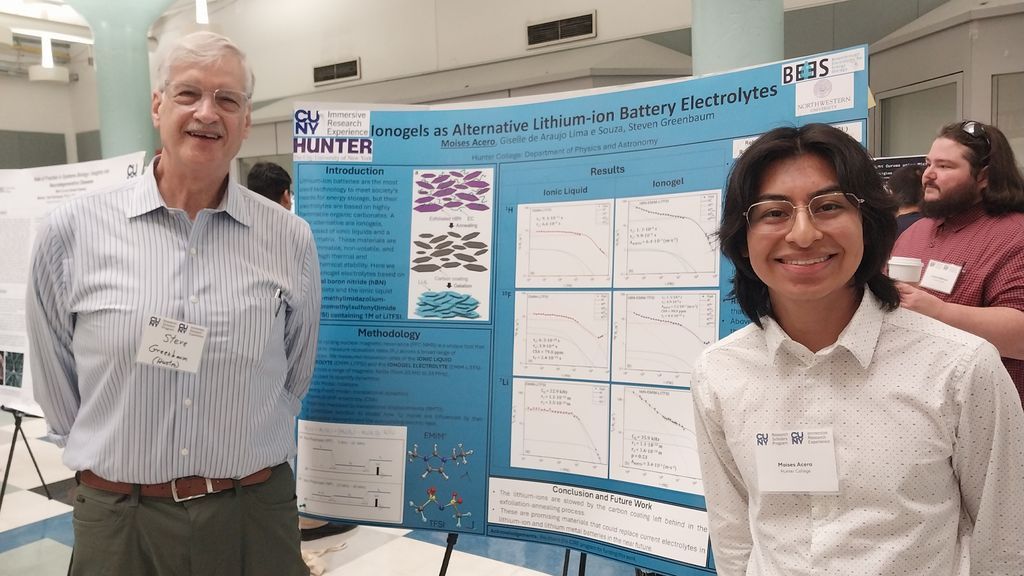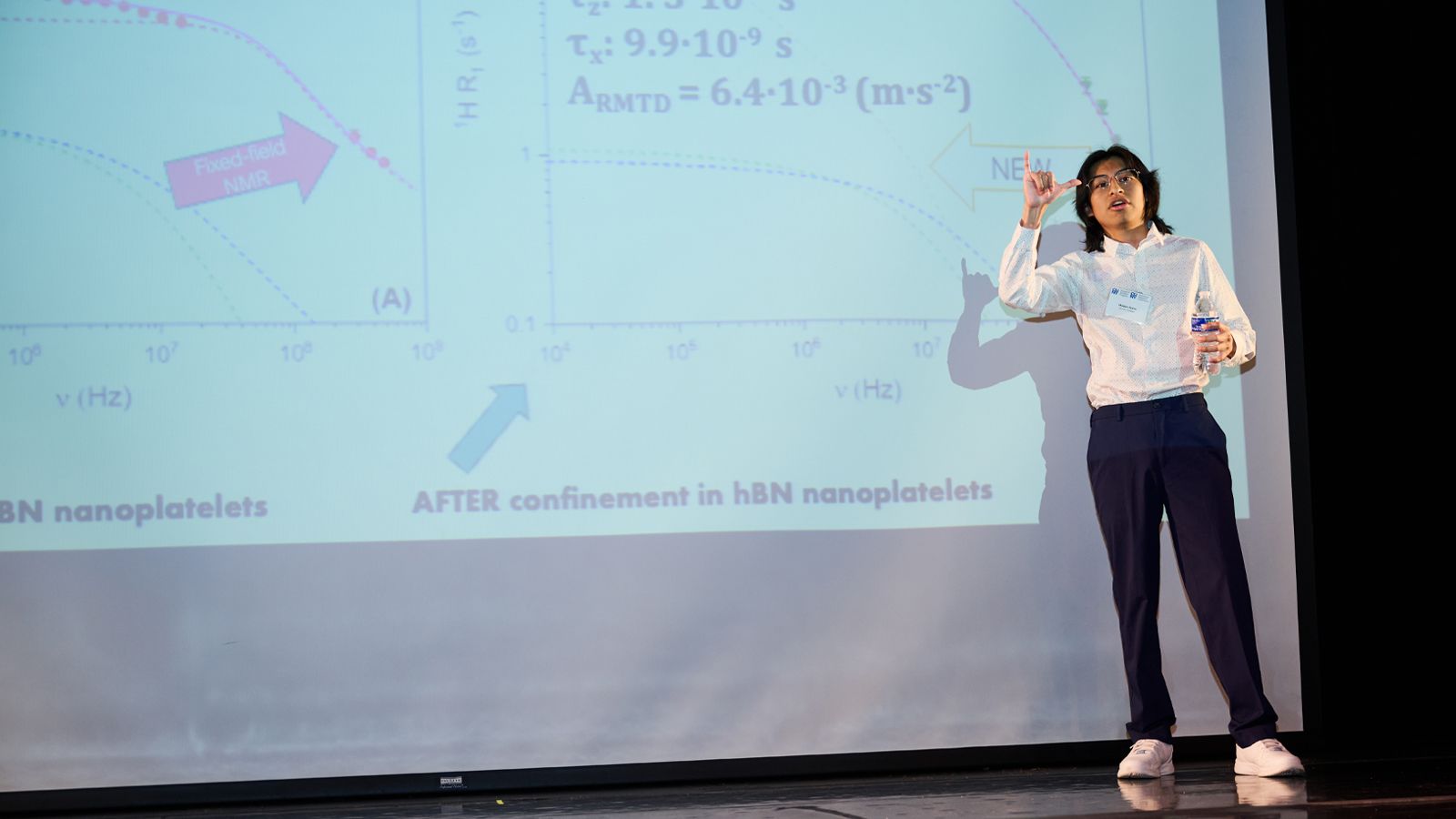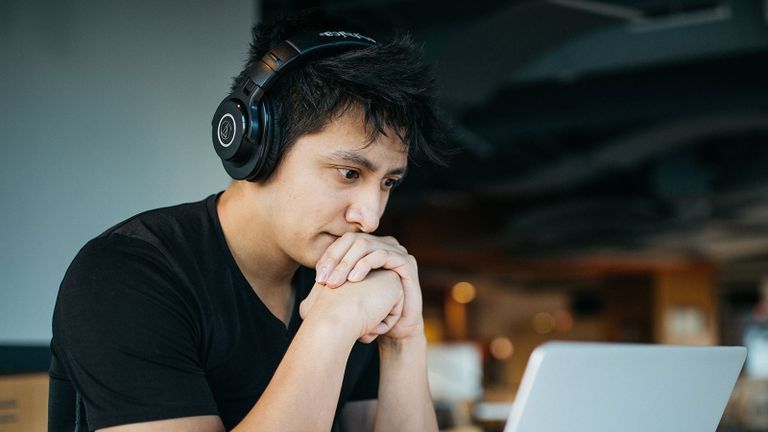Two Hunter undergraduates were among the lead authors of a peer-reviewed article on lithium-ion battery electrolytes in a top physics journal — a rare and remarkable achievement.
Moises Acero ’25 and rising senior Emilia Pelegano-Titmuss ’26 are the second and third authors of “Ion dynamics in hexagonal boron nitride ionogel electrolytes,” a paper published in the Journal of Chemical Physics. What’s more, the illustration they created for the article landed on the cover.
“It isn’t often when a student gets to be a co-author on a peer-reviewed publication,” said the paper’s principal investigator, Distinguished Professor of Physics Steven Greenbaum, the director of the NASA-Hunter College Center for Advanced Energy Storage for Space. “That’s the holy grail.”
The research highlights Hunter’s role as an engine of social mobility and anchor institution and training ground providing opportunities for high-impact, world-changing research in mathematics and the sciences for diverse students.
Acero is a prime example. Born in Mexico, he migrated with his family to Queens and attended Maspeth High School, where he thrived in the sciences. The first in his family to attend college, he enrolled as a computer science major at Hunter, hoping to enter a field with high earning potential. Still, he could not get the natural sciences out of his mind.
“I decided that I wanted to pursue something that was a little bit more fundamental, rather than strictly only computers and mathematics,” he said.
It was in a Hunter science class where Acero met Emilia Pelegano-Titmuss ’26, who introduced him to the concept of undergraduate research, as well as programs that could help make working in a lab a reality.
Acero was accepted into the Maximizing Access to Research Careers (MARC) program, which aims to increase the number of students from underrepresented groups in biomedical and behavioral research, funded by the National Institutes of Health (NIH).
Acero was also selected for the CUNY Immersive Research Experience, which provides year-long research opportunities for juniors and seniors at all 11 CUNY four-year colleges. The program aims to encourage undergraduate participation in authentic research and increase persistence in the fields of science, technology, engineering, and mathematics (STEM).
And that’s how he was tapped as the main undergraduate to handle the data collection for the project whose results would end up in the peer-reviewed article.
“The actual most difficult part was finding what that data tells us,” Acero said. “One of my favorite parts was seeing how different areas of physics, math, computation, and computer science came together to give us the results.”
Lithium-ion batteries sometimes explode because heat generated from shorts can make the flammable electrolyte liquids catch fire.
The research arose from a collaboration with Northwestern University that sought to find safer electrolytes for lithium-ion batteries.
Giselle de Araujo Lima e Souza, a postdoctoral research associate, is the first author, which means she led the central experiments of the project. Co-author Pelegano-Titmuss, a recent winner of the prestigious Goldwater Scholarship, is working at a lab at Caltech for the second summer in a row.
As for Acero, who graduated from Hunter this past May, he is working in Greenbaum’s lab until the fall, when he starts a doctoral program in physics at CUNY Graduate Center. He encourages Hunter’s next crop of first year students who might be thinking about majoring in science to consider getting into a lab.
“Research is extremely rewarding. Not just for knowledge’s sake, but also because it’s something that can apply to wider society,” Acero said, noting that though he was raised in New York City, he wasn’t aware of the many programs he could’ve gotten involved in when he was younger — such as the American Natural History Museum's Science Research Mentoring Program for high school students.
For that, he’ll always be appreciative of friends and professors he met at Hunter.
“I’m grateful for the folks I found here, especially Professor Greenbaum,” he said.

Steven Greenbaum and Moises Acero
As he starts the PhD program at CUNY’s Graduate Center, Acero be sure to hear from Greenbaum, who said he makes it a point to keep in touch with former students and lab researchers.
Out of the total of perhaps a dozen Black women who have earned PhDs in physics at MIT, two were Greenbaum’s students and he said he checks in with them at least once per year.
“Mentoring is part and parcel of what I do,” Greenbaum said. “It’s not a distraction from the research; it’s part of it,” he said. “The more you do for students, the more they’ll do for you.”
Throughout his more than 40 years as a physics professor, Greenbaum has usually had four undergraduates in his laboratory at any given time.
"The sciences at Hunter are very serious,” Greenbaum said. “Research experience is very important. You can’t just do well in your classes and expect to get into graduate school. Time in a lab is something that we emphasize, and we make opportunities available for undergraduates, with programs like MARC, in which students get tuition and a stipend. Instead of having a student be a cashier at Target, they could be in a lab doing research. It is a great model.”


